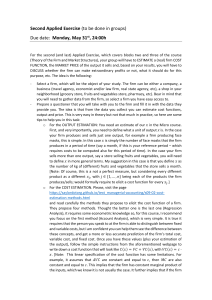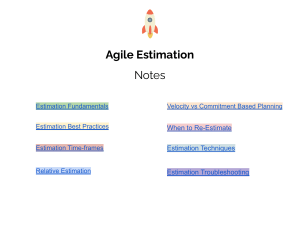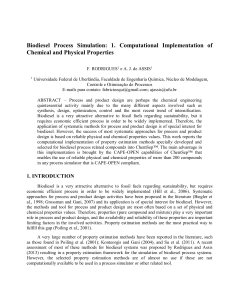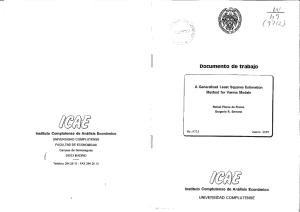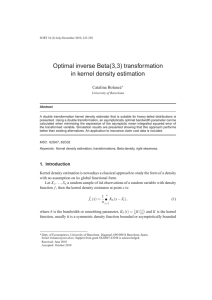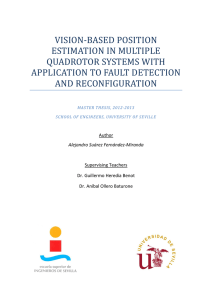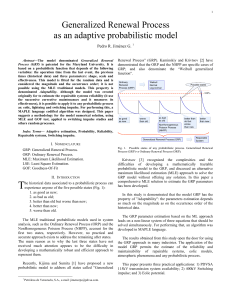Robust Estimation Techniques for GNSS Positioning
Anuncio
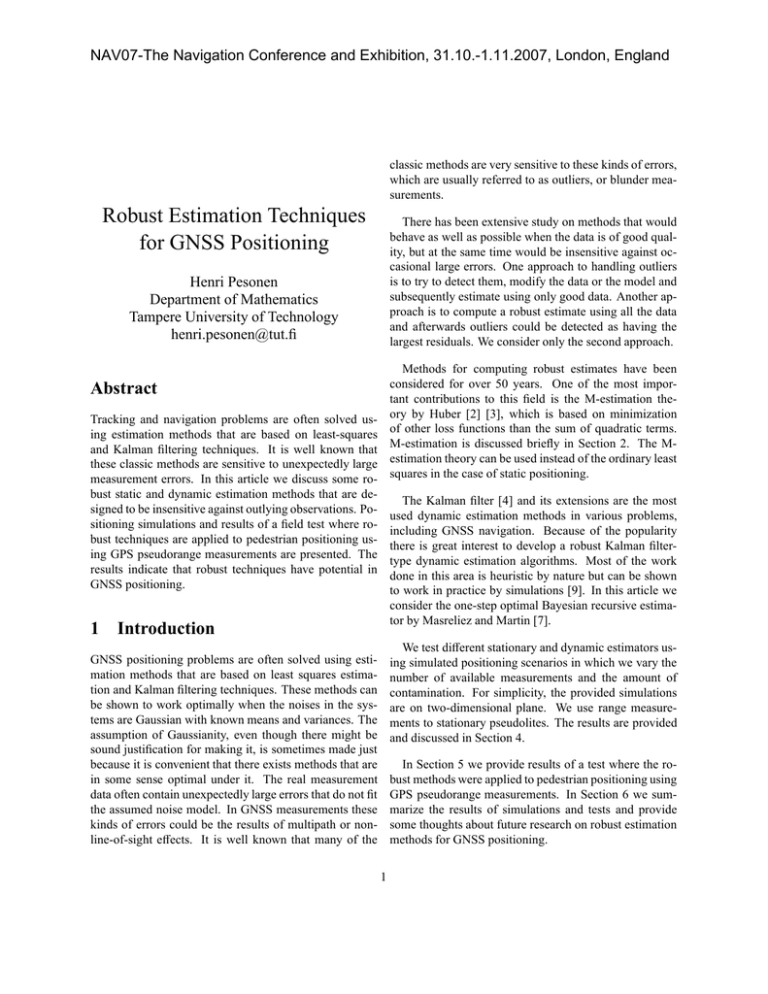
NAV07-The Navigation Conference and Exhibition, 31.10.-1.11.2007, London, England classic methods are very sensitive to these kinds of errors, which are usually referred to as outliers, or blunder measurements. Robust Estimation Techniques for GNSS Positioning There has been extensive study on methods that would behave as well as possible when the data is of good quality, but at the same time would be insensitive against occasional large errors. One approach to handling outliers is to try to detect them, modify the data or the model and subsequently estimate using only good data. Another approach is to compute a robust estimate using all the data and afterwards outliers could be detected as having the largest residuals. We consider only the second approach. Henri Pesonen Department of Mathematics Tampere University of Technology [email protected] Methods for computing robust estimates have been considered for over 50 years. One of the most important contributions to this field is the M-estimation theory by Huber [2] [3], which is based on minimization of other loss functions than the sum of quadratic terms. M-estimation is discussed briefly in Section 2. The Mestimation theory can be used instead of the ordinary least squares in the case of static positioning. Abstract Tracking and navigation problems are often solved using estimation methods that are based on least-squares and Kalman filtering techniques. It is well known that these classic methods are sensitive to unexpectedly large measurement errors. In this article we discuss some robust static and dynamic estimation methods that are designed to be insensitive against outlying observations. Positioning simulations and results of a field test where robust techniques are applied to pedestrian positioning using GPS pseudorange measurements are presented. The results indicate that robust techniques have potential in GNSS positioning. The Kalman filter [4] and its extensions are the most used dynamic estimation methods in various problems, including GNSS navigation. Because of the popularity there is great interest to develop a robust Kalman filtertype dynamic estimation algorithms. Most of the work done in this area is heuristic by nature but can be shown to work in practice by simulations [9]. In this article we consider the one-step optimal Bayesian recursive estimator by Masreliez and Martin [7]. 1 Introduction We test different stationary and dynamic estimators using simulated positioning scenarios in which we vary the number of available measurements and the amount of contamination. For simplicity, the provided simulations are on two-dimensional plane. We use range measurements to stationary pseudolites. The results are provided and discussed in Section 4. GNSS positioning problems are often solved using estimation methods that are based on least squares estimation and Kalman filtering techniques. These methods can be shown to work optimally when the noises in the systems are Gaussian with known means and variances. The assumption of Gaussianity, even though there might be sound justification for making it, is sometimes made just because it is convenient that there exists methods that are in some sense optimal under it. The real measurement data often contain unexpectedly large errors that do not fit the assumed noise model. In GNSS measurements these kinds of errors could be the results of multipath or nonline-of-sight effects. It is well known that many of the In Section 5 we provide results of a test where the robust methods were applied to pedestrian positioning using GPS pseudorange measurements. In Section 6 we summarize the results of simulations and tests and provide some thoughts about future research on robust estimation methods for GNSS positioning. 1 2 Robust estimation a sequence of weighted LS-problems. This is the iteratively reweighted least squares (IRLS) method which is given by Algorithm 1 [8]. It has to be noted that IRLS algorithm has only first degree convergence and needs reparameterization at each iteration, hence it is not computationally very atractive choice. Despite of this it is a much-used algorithm, possibly because of the available software for solving LS-problems. Also, with a good initial estimate, the algorithm often converges after only few iterations if the stopping criteria are not too strict. One of the most used robust M-estimators is the one minimizing the original Huber’s loss function [2] ( 2 k|r| − k2 , |r| ≥ k ρH (r) = r2 . (6) |r| < k 2, In the following two sections we consider estimation methods for static and dynamic linear estimation problems. Linear problems are considered as in this article we consider positioning with range and pseudorange measurements obtained from pseudolites or satellites located far away from the receiver. It is assumed that this results in almost linear estimation problems. Consider the ordinary linear regression problem y = Hx + v, (1) where y is the vector of observations, H is the design matrix of full rank and v is the observation error with variance V(v) = R. In the case of independent errors R is a diagonal matrix with elements σi . In LS estimation we Note that Huber’s loss function corresponds to a density function that is Gaussian in the middle and double exminimize the quadratic cost function ponential in the tails. The Huber’s ψ-function in Fig. 1 X 1X (ri (x)/σi )2 , ρ(ri (x)) = (2) shows the influence of a residual to the estimate. 2 i Another well-known loss function is the Tukey’s i bisquare where r(x) = y − Hx. The estimate that minimizes the 2 k quadratic cost function is , |r| ≥ k 6 ( 3 ) 2 (7) ρ (r) = 2 B r k , |r| < k x̂ = (H T R−1 H)−1 H T R−1 y, (3) 6 1− 1− k which is a linear combination of observations and as such the influence of outlying observations is not bounded in any way. To introduce robustness into the estimation problem, Huber [2] suggested to minimize less rapidly increasing functions than (2). In more general form the estimation problem can be written as X x̂ = arg min ρ(ri (x)/σi ). (4) x which is not a convex function and as such the convergence to a global minimum is not quaranteed. Note that for residuals in the tails Tukey’s loss function gives zero influence as illustrated by Figure 1. The effect is same as leaving out particular observations from the system and hence extra care has to be used when minimizing these kinds of loss functions. With a bad initial estimate the IRLS algorithm can ignore perfectly good observations and converge to a local minimum. i Note that when ρ(·) = − ln pv , (4) is a maximum likelihood estimation problem. This is why Huber referred his 3 Robust dynamic estimation framework as M-estimation. When ρ(·) is a convex funcIn order to robustify the Kalman filter, Masreliez and Martion, we can solve (4) from the equation tin [7] approached the linear regression problem (1) using X the Bayesian framework dri (x)/σi = 0. (5) ψ(ri (x)/σi ) dx y = Hx + v, x ∼ Φ( x̄, P), v ∼ F, (8) i where Φ is Gaussian and Fv is symmetric and heavyand the solution is unique. Although there does not exist a single best method for tailed. There is a restriction for the form of Fv that resolving (5), one of the most popular techniques is to solve quires the existence of a transformation T such that the 2 a family of estimators Θ. Mathematically it is the saddlepoint of the game Algorithm 1: IRLS Set initial estimate x(0) Set error tolerance ǫ k=0 for k = 1, 2, . . ., N do r(k−1) = y − Hx(k−1) wi(k−1) = W (k−1) min max V(F, θ) = V(F0 , θ0 ) = max min V(F, θ), θ∈Θ F∈F ψ(ri(k−1) /σ) |ri(k−1) /σ| diag[w1(k−1) , . . . , wn(k−1) ] −1 T (k−1) T (k−1) x̂ = x̄ + PH T T T Ψ(u), #! " h i dψ(u) P. E ( x̂ − x)( x̂ − x)T ≤ I − PH T T T T HEF0 du LS Huber (k=1.2) 0 −2 −4 0 2 4 6 Figure 1: ψ-functions indicate the influence that a sample has on an M-estimator. = Fk xk + Γk wk (13) yk x0 = ∼ Hk x k + v k Φ( x̄0 , P0 ), (14) (15) Algorithm 2: Robust Kalman-type filter x̂0|0 ∼ Φ( x̄0|0 , P0|0 ) for k = 1, 2, . . . do x̄k|k−1 = Fk−1 x̄k−1|k−1 T Pk|k−1 = Fk−1 Pk−1|k−1 Fk−1 + Γk−1 Qk−1 ΓTk−1 T T x̄k|k = x̄k|k−1 + Pk|k−1 Hk T Ψ(T (yhk − Hi k x̄k|k−1 )) Pk|k−1 Pk|k = I − Pk|k−1 HkT T kT T k Hk EF0 dψ(u) du Approximate p x̂k|k ≈ Φ( x̄k|k , Pk|k ) end transformed innovation variable u = T (H(x − x̄) + v) xk+1 where wk ∼ Φ(0, Qk ) and vk is heavy-tailed, symmetric non-Gaussian for which the transformation T discussed previously exists. The Bayesian robust estimator for the linear model is applied to the filtering problem sequentially at each timestep k. This is carried out by heuristically approximating the posterior density with a Gaussian distribution. The robust filter is presented by Algorithm 2. Bisquare (k=4) −2 (12) The ψ-function as defined in Section 2 is the derivative of the loss function corresponding to the ML-estimate of the least favorable distribution. Consider the linear filtering problem 4 2 (11) where [Ψ(u)]i = ψ(ui ), is bounded from above as y 6 −4 (10) where Θ is a family of estimators and θ0 the min-max estimator. Masreliez and Martin [7] showed that if Fv is of required form, the error variance for an estimator = (k) x = H W H H W if ||x(k) − x(k−1) || < ǫ then Stop end end −6 −6 F∈F θ∈Θ (9) has a distribution Fu which has a density function that is an even function of all its parameters and all the marginal distributions Fui are members of a family of distributions F . A transformation as such exists for example if the measurements errors are independent and have distribuTwo possible choices for family of distributions F , as given by Masreliez and Martin [7], are the ǫ-contaminated tions from the same family of distributions. Let F0 be the least favorable member of the family of family distributions F i.e. the distribution that minimizes the Fǫ = {F | F = (1 − ǫ)Φ(·|0, 1) + ǫH, (16) Fisher information for the best possible estimator θ0 of H has a symmetric density , 3 and the p-point family the expectation can now computed from n F p = F | F(−y p ) = Φ(−y p |0, 1) = 2p , o F has a symmetric density and is continuous in ± 2p , " # dψ(u) EF p,0 (24) du !! Z yp 1 1 x f p,0 (x)dx = 1 + tan2 2 −y p (my p )2 2my p (17) which is discussed also in Martin and Masreliez [6]. The least favorable density for ǫ-contaminated family is The above formulation of a robustified Kalman-type filh i 1−ǫ ter is just one of many. More general formulations than 1 2 |x| < k √2π exp h− 2 x , i Algorithm 2 can be found for example in Kovačević et al. (18) fǫ,0 (x) = 1−ǫ √ exp −k|x| + 1 k2 , |x| ≥ k, [5] and Schick and Mitter [10]. 2 2π where k is a function of the fraction of contamination ǫ and can be solved from the equation 4 Simulations 2 ǫ φ(k|0, 1) − 2Φ(−k|0, 1) = , k 1−ǫ (19) We compare the different positioning methods using Matlab simulations. It is not a particularly easy task to choose where φ is the Gaussian probability density function. The the best way to compare the methods [11], as judged by expectation needed for the upper bound of the variance is different criteria several completely different filters can be the best one. # " In this work we choose to look at the frequential bedψ(u) = 1 − 2Φ(−k|0, 1). (20) haviour of the estimation methods. Instead of considering EFǫ,0 du the performance of the methods in one particular positionFor ǫ-contaminated family the error bound (12) is only an ing scenario with a specific track and a set of observations, upper bound as it is not possible that the innovation has we generated 200 tracks of 120 epochs and a set of observations for each of the tracks and look at the frequential the least favorable distribution as its distribution. The least favorable density for the p-point family of performance of the methods. distributions is For simplicity we consider positioning with range mea surements from a set of stationary pseudolites located far x 2 |x| ≤ y p K cos 2my p , f p,0 (x) = (21) away at coordinates s , . . . , s . h i 2K 1 1 2 2 1 l K cos ( ) exp |x| > y p . 2m p cos 2m (y p − |x|) , To generate the tracks we used the piecewise constant The normalization factor K can be solved using the prop- white noise acceleration model [1]. erty of all the distributions of the family that the i h distrixk+1 = Fk xk + Γk wk , (25) butions have the mass 1 − p inside the interval −y p , y p , # " 1 where the point y p is determined by Φ(−y p |0, 1) = p/2. 2 I2×2 , (26) Γk = The parameter value m minimizing the variance can be I2×2 solved from " !# " !# with 1 1 2m − p 1 + tan2 2m + tan = 0. (22) (27) wk ∼ N 0, 0.22 I2×2 2m 2m Using the ψ-function of the p-point family of estimators ψ p (x) = x 1 my p tan 2my p sign(y p ) 1 my p tan 2m , |x| ≤ y p , |x| > y p , F= " I2×2 0 I2×2 I2×2 # . (28) (23) The state xk contains the position and velocity coordinates. 4 Measurements were generated with a model where the observation noise + vk , vk ∼ (1 − ε)N(0, 102 Il×l ) + εN(0, 502 Il×l ). △ 90% EKF 67% REKFp 33% REKFε LS Huber Bisquare ◦ 3 10 (29) Error bound ||xk − s1 || .. yk = . ||xk − sl || 4 measurements/epoch 4 10 2 10 1 10 (30) 0 10 ε= We generated several positioning scenarios by varying the fraction of contamination ε as well as the number of measurements. In our tests we compared three static estimation methods. The performance of M-estimates with Huber’s and Tukey’s bisquare loss functions were compared against ordinary least squares solution. The tuning parameters for the M-estimators were chosen as k = 1.345 for Huber and k = 4.5 for bisquare. Also three dynamic estimation methods were tested. Two robust filters using the assumptions of measurement errors F ∈ Fǫ and ∈ F p (REKFǫ and REKF p ) were compared against the performance of the ordinary EKF. The parameter values were chosen as ǫ = 0.1 and p = 0.5. The results of simulations are given in Figures 2 - 3, where the bounds that contain 33%, 67% and 90% of the errors are plotted. Simulations show how extremely sensitive the classic methods are to even small amount of contaminated measurements. Robust filters offer good protection against unmodeled errors with only about four times more computation time than that of the Kalman filter. The M-estimation methods can give good results even in very contaminated scenarios but with the lack of prior information the static robust methods need more observations than the dynamic methods to be as robust as dynamic estimation methods. The robust filters perform almost identically on average as do two M-estimators as far as the estimation error is considered. 0 0.01 0.05 0.10 0.20 0.30 Figure 2: Error bounds containing 33%, 67% and 90% of the errors when contamination fraction is ε. 8 measurements/epoch 4 10 3 Error bound 10 EKF REKF p REKFε LS △ 90% 67% 33% ◦ Huber Bisquare 2 10 1 10 0 10 ε= 0 0.01 0.05 0.10 0.20 0.30 Figure 3: Error bounds containing 33%, 67% and 90% of the errors when contamination fraction is ε. Bluetooth GPS Receiver. Now it has to be noted that unlike in simulations, we do not know the exact true track but instead compute the distance to a reference track that is assumed to be very close to the true track. Unfortunately, there is some error also in the reference track which in our tests was the postprocessed DGPS solution with data collected by two NovAtel’s DL-4 GPS receivers. As bad signal environments would also affect the DGPS positioning, we obstruct the line-of-sight of the GPS receiver by covering it. This should results in noisier pseudorange measurements. The state that we are solving now consists of position and velocity coordinates in ECEF coordinates and clock bias and clock drift in meters. The static estimation methods solve only for position and clock bias. The model 5 Tests We tested the methods with real GPS-data. The pseudorange measurements were collected from a 380 second long walk around the campus area of Tampere University of Technology using the Holux GPSlim236 Wireless 5 used for pseudorange measurement is ρi = ||si − x1:3 || + (b − bi )c + Ii + T i + vi , C/N0 (0, ∞) [20, ∞) [25, ∞) [30, ∞) (0, 40] [20, 40] [30, 40] (0, 35] (0, 30] (31) ave(SV) 8.7 8.2 6.6 4.8 6.9 6.4 2.9 5.2 3.7 % of epochs when # SV < 4 0 0 0.6 22 0 0 58 0.7 50 where we assume that satellite clock bias bi , the delays Ii , T i correponding to ionophere and troposphere can be solved accurately. Also, for simplicity the model 2 √ assumes independent errors vi ∼ N 0, 1500/ C/N0 , where C/N0 is the carrier-to-noise ratio of the ith mea- Table 1: 0.33 CERP radius [m] when observations with carriersurent. to-noise ratios within certain intervals are used. The filters use the constant velocity and clock drift motion model xk+1 = Fk xk + wk (32) we used to compute the solutions. Different measurement 1 3 1 2 0 3 ∆t Qc 2 ∆t Qc sets were selected based on the carrier-to-noise ratios of ∆tQc 0 wk ∼ N 0, 12 ∆t2 Qc (33) the measurements. The results are collected in the Ta 0 0 Qclock bles 2-5 in the form of the percentages of time when the where ∆t is the length of the time interval between suc- estimate is within some bound from the reference posicessive epochs, Qc = diag(0.1, 0.1, .01) in ENU coordi- tion. The carrier-to-noise intervals and corresponding avnates and erage number of available satellites and the percentage " # of epochs when only less than four measurements were 1/3∆t3 σ2c 1/2∆t2 σ2c 2 available is collected in Table 1. Qclock = , σ = 2. (34) c 1/2∆t2 σ2c ∆tσ2c All the static estimation methods give very similar reM-estimators with Huber and bisquare loss functions sults but robust filters give often little better results than use parameters k = 0.5 and k = 2.5 correspondingly. The the Kalman filter, but the difference is not very large. It is robust Kalman-type filters use parameter values p = 5 and debatable if the accuracy gained is worth the extra computation time. Our Matlab implementations of the robust ǫ = 0.2 filters required about four times more computation time than our implementation of the EKF. 300 C/N0 EKF REKF p REKFǫ LS Huber Bisquare (0, ∞) 30.8 28.7 27.7 24.4 24.4 24.4 [20, ∞) 31.4 30.2 30.2 25.9 25.9 25.9 [25, ∞) 30.2 39.3 39.3 23.5 23.5 23.5 [30, ∞) 8.5 23.2 19.5 13.7 13.7 13.7 (0, 40] 28.4 32.3 32.9 13.4 13.4 13.4 [20, 40] 28.7 32.6 33.2 13.1 13.1 13.1 [30, 40] 16.8 7.6 17.1 3.7 3.7 3.7 (0, 35] 4.3 8.2 6.7 1.2 1.2 1.2 (0, 30] 1.2 0.9 1.2 0.3 0.3 0.3 200 # obs 100 0 0 Table 2: How often (%) the estimate is within 5m of the refer10 20 C/N0 30 40 50 ence track. Figure 4: The distribution of measured carrier-to-noises. 6 Conclusions From the collected pseudorange measurement data we In this article we reviewed robust methods that can be selected different combinations of measurements which used in positioning applications. Both static and dynamic 6 cases were considered. In simulations it could be shown that the robust methods perform clearly better than the classic methods even with small amount of bad observaC/N0 EKF REKF p REKFǫ LS Huber Bisquare (0, ∞) 51.8 60.1 63.7 53.0 53.0 53.0 tions. This is because the simplified nature of the simula[20, ∞) 48.5 62.2 64.3 55.2 55.2 55.2 tions, i.e. measurement noise in independent and outliers [25, ∞) 57.3 70.4 73.2 52.7 52.7 52.7 [30, ∞) 55.5 61.6 55.2 32.3 32.3 32.3 occur independently with a certain probability. (0, 40] 46.3 51.5 51.8 29.0 29.0 29.0 We tested the methods also with typical GPS pseudor[20, 40] 44.8 49.7 50.9 31.1 31.1 31.1 [30, 40] 39.6 48.2 54.6 8.8 8.8 8.8 ange measurements in pedestrian positioning application. (0, 35] 20.7 24.7 25.9 4.9 4.9 4.9 We used a DGPS solution as a reference track and col(0, 30] 6.1 7.3 6.4 0.6 0.6 0.6 lected the test data with consumer priced GPS receiver Table 3: How often (%) the estimate is within 10m of the ref- which was covered to obtain noisier measurements. Roerence track. bust Kalman-type filters seem to give almost always better results than the Kalman filter but the difference between methods is not as distinctive as in simulations. This might be because of several reasons. First, all the robust methods discussed in this article assume zero mean noise but in reality pseudorange measurements contain interference that can not be modeled exactly but instead cause C/N0 EKF REKF p REKFǫ LS Huber Bisquare the noise to be biased. Second, the outliers are not in(0, ∞) 79.6 80.8 81.7 71.6 71.6 71.6 [20, ∞) 74.7 80.8 82.9 72.6 72.6 72.6 dependent but tend to occur during successive epochs e.g. [25, ∞) 83.5 94.5 93.3 70.7 70.7 70.7 while we are in an urban canyon and are not spread evenly [30, ∞) 80.8 93.0 92.7 46.3 46.3 46.3 (0, 40] 75.3 76.5 77.7 47.9 47.9 47.9 in time. [20, 40] 67.1 75.0 76.2 50.0 50.0 50.0 For future work tests with extremely noisy data should [30, 40] 61.3 64.0 73.5 13.7 13.7 13.7 (0, 35] 55.5 51.2 52.7 15.2 15.2 15.2 be carried out. In that kind of environment, a good refer(0, 30] 13.4 18.6 15.2 0.9 0.9 0.9 ence track would be very hard to obtain but easiest soluTable 4: How often (%) the estimate is within 15m of the ref- tion would be to evaluate the results graphically. To handle patchy outliers, dynamic estimators that are based on erence track. model selection could be applied. Also it would be interesting to apply robust methods to sensor-aided GNSS positioning and, in general to hybrid positioning. C/N0 EKF REKF p REKFǫ LS Huber Bisquare (0, ∞) 0 0 0 3.0 1.8 1.8 [20, ∞) 0 0 0 2.7 2.7 2.7 [25, ∞) 0 0 0 3.4 3.4 3.4 [30, ∞) 0 0 0 6.1 6.1 6.1 (0, 40] 0 0 0 11.9 10.1 10.1 [20, 40] 0 0.6 0 12.2 12.2 12.2 [30, 40] 11.9 10.7 11.3 12.5 12.5 12.5 [0, 35] 0 0 0 45.4 45.1 45.1 (0, 30] 0 1.2 0.3 41.5 41.5 41.5 References [1] Yaakov Bar-Shalom, X. Rong Li, and Thiagalingam Kirubarajan. Estimation with Applications to Tracking and Navigation. John Wiley & Sons, Inc., 2001. [2] Peter J. Huber. Robust estimation of a location parameter. The Annals of Mathematical Statistics, 35 (1), March 1964. Table 5: How often (%) the estimate is not within 50m of the reference track. [3] Peter J. Huber. Robust Statistics. John Wiley & Sons, Inc., 1981. 7 [4] R. E. Kalman. A new approach to linear filtering and prediction problems. Transactions of the ASMEJournal of Basic Engineering, 82, 1960. [5] Branko D. Kovačević, Željko M. Durović, and Sonja Glavaški. On robust Kalman filtering. International Journal of Control, 56(3):547–562, 1992. [6] R. Douglas Martin and C. J. Masreliez. Robust estimation via stochastic approximation. IEEE Transactions on Information Theory, 21(3):263–271, May 1975. [7] C. Johan Masreliez and R. Douglas Martin. Robust Bayesian estimation for the linear model and robustifying the Kalman filter. IEEE Transactions on Automatic Control, 22(3), 1977. [8] M. R. Osborne. Finite algorithms in optimization and data analysis. John Wiley & Sons Ltd., 1985. [9] Tommi Perälä and Robert Piché. Robust Extended Kalman filtering in hybrid positioning applications. In Proceedings of the 4th Workshop on Positioning, Navigation and Communication (WPNC’07), March 22, pages 55–64, 2007. [10] Irvin C. Schick and Sanjoy K. Mitter. Robust estimation in the presence of heavy-tailed observation noise. The Annals of Statistics, 22(2):1045–1080, June 1994. [11] Niilo Sirola, Simo Ali-Löytty, and Robert Piché. Benchmarking nonlinear filters. In Nonlinear Statistical Signal Processing Workshop NSSPW06, 2006. 8
